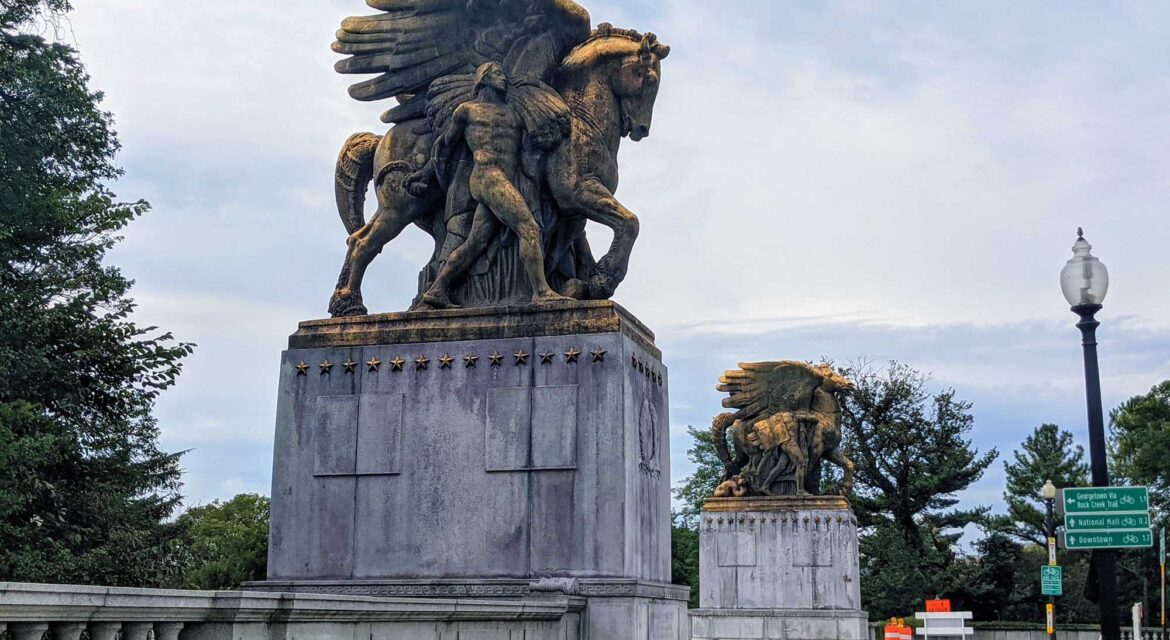 Gilded-bronze equestrian statues known as the Arts of War and the Arts of Peace flank the entrances to a bridge and parkway in Washington, D.C. Created to enhance a plaza as well as to a newly constructed bridge, the statue groups represent an especially imaginative approach to doing so that has connected audiences to the area and to a historic period of the city.
Gilded-bronze equestrian statues known as the Arts of War and the Arts of Peace flank the entrances to a bridge and parkway in Washington, D.C. Created to enhance a plaza as well as to a newly constructed bridge, the statue groups represent an especially imaginative approach to doing so that has connected audiences to the area and to a historic period of the city.

Adorning Two Distinct Washington D.C. Bridges
 Originally commissioned in 1929 by the Arlington Memorial Bridge Commission, the two sets of statue groups were created by different artists to adorn two different areas in the plaza near the Lincoln Memorial. Comprised of “Music and Harvest” and “Aspiration and Literature,” the Arts of Peace were created by James Earle Fraser. They frame the entrance to the Rock Creek and Potomac Parkway. The Arts of War include “Valor” and “Sacrifice” and were sculptured by Leo Friedlander. They reside at the entrance to Arlington Memorial Bridge.
Originally commissioned in 1929 by the Arlington Memorial Bridge Commission, the two sets of statue groups were created by different artists to adorn two different areas in the plaza near the Lincoln Memorial. Comprised of “Music and Harvest” and “Aspiration and Literature,” the Arts of Peace were created by James Earle Fraser. They frame the entrance to the Rock Creek and Potomac Parkway. The Arts of War include “Valor” and “Sacrifice” and were sculptured by Leo Friedlander. They reside at the entrance to Arlington Memorial Bridge.
Created in bronze instead of granite to save costs, all of the models were completed in 1938, but not cast until 1949 with funding from the Italian government. The statues were dedicated in September 1951. Serious problems with the gilding were recognized by the late 1950s, and by 1971, the National Park Service undertook a program of both interior and exterior work, including regilding the statues.
Both are in a style of Art Deco and feature numerous Neoclassical figures that represent different themes and meanings. The Arts of Peace feature a winged horse symbolizing the ancient god of Poetry. “Valor” and “Sacrifice” have a figure that is symbolic of Mars, the ancient Roman god of war. All of the pedestals have 36 gilded bronze stars that represent the number of states in the United States at the time of the Civil War. Each is about 19 feet tall and are said to be some of the largest equestrian sculptures in the United States.
The sculptures have helped to define the East and West Potomac Parks Historic District, which was added to the National Register of Historic Places in 1973. Their presence has cultivated a sense of connection with audiences to the era when they were created but have also provided Washington D.C. with icons that are utilized as a means of identity by residents and visitors. This impact highlights how many different ways monuments that adorn what would otherwise be an empty bridge or plaza can make an impact.

Welcoming Audiences of All Types
 The entrance of Arlington National Cemetery sits in the background of the Arts of War, while the Arts of Peace usher in audiences to one of the most historic areas of Washington D.C. In doing so, the statue groups have been able to welcome audiences of all types in an imaginative way that has resonated with them on multiple levels. Doing so has created engagement and opportunity in ways that can be seen, directly and indirectly, cultivating connections that will continue to create a positive impact on the entire city.
The entrance of Arlington National Cemetery sits in the background of the Arts of War, while the Arts of Peace usher in audiences to one of the most historic areas of Washington D.C. In doing so, the statue groups have been able to welcome audiences of all types in an imaginative way that has resonated with them on multiple levels. Doing so has created engagement and opportunity in ways that can be seen, directly and indirectly, cultivating connections that will continue to create a positive impact on the entire city.

